 "ttyymmnn" (ttyymmnn)
"ttyymmnn" (ttyymmnn)
08/09/2016 at 12:35 • Filed to: planelopnik, planelopnik history
 10
10
 15
15
 "ttyymmnn" (ttyymmnn)
"ttyymmnn" (ttyymmnn)
08/09/2016 at 12:35 • Filed to: planelopnik, planelopnik history |  10 10
|  15 15 |
Welcome to This Date in Aviation History , getting of you caught up on milestones, important historical events and people in aviation from August 6 - August 9.
!!! UNKNOWN CONTENT TYPE !!!
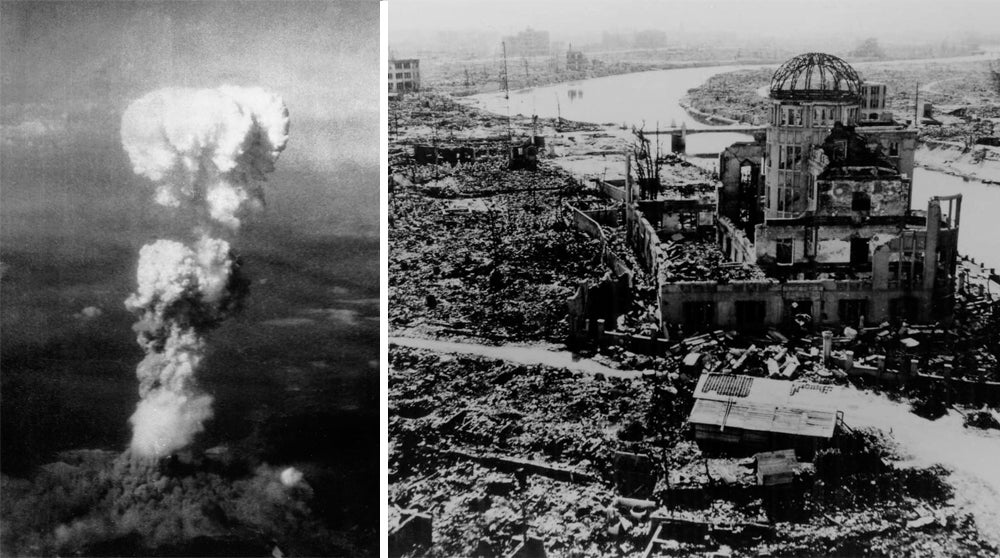
August 6, 1945 – The United States drops the Little Boy atomic bomb on the Japanese city of Hiroshima. Following the American victory in the !!!error: Indecipherable SUB-paragraph formatting!!! in June 1942, the tide of battle in the Pacific turned to America and her allies. The methodical !!!error: Indecipherable SUB-paragraph formatting!!! campaign began, as America captured strategic islands to build air bases while bypassing large groups of entrenched Japanese soldiers on other islands and cutting off their flow of supplies. With the capture of Guam, Saipan and Tinian in June and August 1944, the US now had bases close enough to begin flying !!!error: Indecipherable SUB-paragraph formatting!!! bombing missions against Japan. But even the most modern bomber in the world could only be so accurate from high altitude, and with so much of the Japanese war production spread throughout the cities and into people’s homes, the strategic bombing wasn’t terribly effective. Even after General !!!error: Indecipherable SUB-paragraph formatting!!! changed tactics in 1943 to the !!!error: Indecipherable SUB-paragraph formatting!!! of Japanese cities, resulting in huge loss of life, Japan fought on. It appeared that an invasion of the island would be the only way to end the war. In the largest amphibious assault of WWII, the US secured the island of !!!error: Indecipherable SUB-paragraph formatting!!! on June 22, 1945 to serve as a launching point for the planned !!!error: Indecipherable SUB-paragraph formatting!!! , a two-part invasion of Japan slated to begin on November 1, 1945. War planners knew that the invasion would be costly, and while initial estimates expected 130,000-220,000 Allied casualties, once it became clear that the Japanese were preparing defenses at the intended landing sites, casualty estimates leapt to 1.7-4 million, with 400,000-800,000 dead. The US produced a half million !!!error: Indecipherable SUB-paragraph formatting!!! medals in preparation for the invasion. But could the war be ended without an invasion? Could the Americans strike such a devastating blow that the Japanese would finally capitulate? Development of a nuclear bomb in the US dates back to before the war, when scientists who had fled Nazi Germany came to America with dire warnings of German advances in atomic science. In 1939, the Americans began working on their own bomb to counter the perceived German threat, with Berlin as a potential target, but the first successful test was not carried out until July 1945, after the war in Europe had ended. The organizational effort to create the group of pilots and planes that would drop the new weapon had begun in 1944 with the creation of the !!!error: Indecipherable SUB-paragraph formatting!!! under the command of Colonel !!!error: Indecipherable SUB-paragraph formatting!!! at Wendover Army Air Field in Utah. They would be flying the !!!error: Indecipherable SUB-paragraph formatting!!! B-29 Superfortress, which was specially modified to carry the new bombs and fitted with fuel injection, reversible pitch propellers, and special bomb bay doors that opened and closed quickly. To save weight and carry more fuel, all defensive armament was removed along with all armor plating.
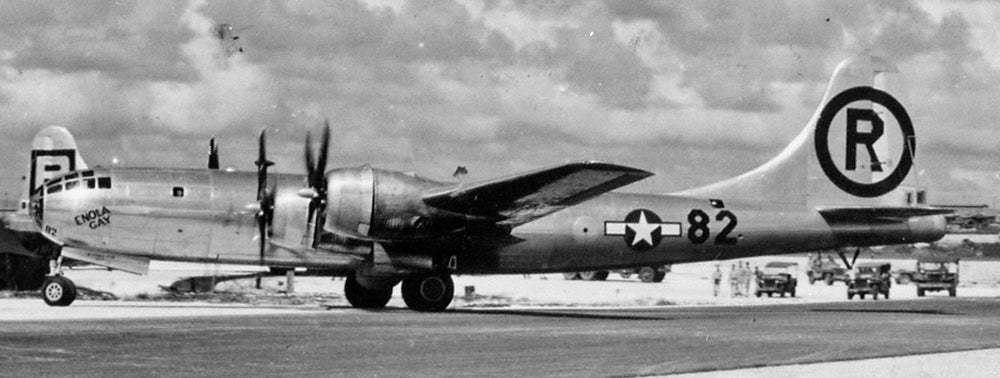
The Enola Gay on Tinian following the mission to Hiroshima
On July 26, 1945, the Allies issued the
!!!error: Indecipherable SUB-paragraph formatting!!!
calling for the unconditional surrender Japan, threatening “prompt and utter destruction” if they did not comply. The Japanese, who had already shown their fanatical desire to fight to the death time and time again throughout the Pacific campaign, rejected the call for surrender. After consideration of numerous cities, Hiroshima was chosen as the first target because of its large military base, but it was also chosen because the Americans wanted a target that was visible enough to have a psychological impact on the Japanese. Tibbets and his crew departed Tinian in their B-29, named
Enola Gay
after Tibbets’ mother, for the six-hour flight to Hiroshima. Over Iwo Jima, they were joined by two other aircraft: the
Great Aritiste
, which was loaded with instruments to measure the explosion, and a second, unnamed B-29 which served as a photo ship. Thirty minutes from the target, mission commander Captain
!!!error: Indecipherable SUB-paragraph formatting!!!
armed the
!!!error: Indecipherable SUB-paragraph formatting!!!
atomic bomb. Tibbets started the bombing run completely unopposed over the unsuspecting city, and released the bomb at 8:15 am (Hiroshima time). The massive explosion killed 70,000-80,000 people in the city, both soldiers and civilians, roughly 30% of the population, and injured another 70,000. 4.7 square miles of the city was destroyed, as massive fires engulfed the many wooden buildings in the city. Those residents who survived suffered horrifying burns, radiation sickness, and a
!!!error: Indecipherable SUB-paragraph formatting!!!
of other maladies. On August 7, President
!!!error: Indecipherable SUB-paragraph formatting!!!
gave an
!!!error: Indecipherable SUB-paragraph formatting!!!
to the nation, and offered Japan a grave warning:
We are now prepared to obliterate more rapidly and completely every productive enterprise the Japanese have above ground in any city. We shall destroy their docks, their factories, and their communications. Let there be no mistake; we shall completely destroy Japan’s power to make war. . . . If they do not now accept our terms they may expect a rain of ruin from the air, the like of which has never been seen on this earth. Behind this air attack will follow sea and land forces in such numbers and power as they have not yet seen and with the fighting skill of which they are already well aware.
Despite Truman’s promise of more nuclear attacks, the Japanese government remained silent, and did not surrender. So Truman made good on his word. The bombing of Hiroshima was followed three days later by another atomic attack on Nagasaki, this one carried out by a B-29 nicknamed !!!error: Indecipherable SUB-paragraph formatting!!! . It was only after this second attack that the Japanese government agreed to unconditional surrender on August 15, 1945, bringing an end to the Second World War. (Mushroom cloud and Enola Gay photos via US Air Force; Hiroshima photo via Hiroshima Peace Memorial Museum)
!!! UNKNOWN CONTENT TYPE !!!

August 8, 1946 – The first flight of the Convair B-36 Peacemaker. In the years leading up to WWII, two schools of thought on aerial bombardment came to the fore: !!!error: Indecipherable SUB-paragraph formatting!!! and !!!error: Indecipherable SUB-paragraph formatting!!! . Following the precepts of Italian general !!!error: Indecipherable SUB-paragraph formatting!!! , and espoused by American !!!error: Indecipherable SUB-paragraph formatting!!! , strategic bombing of enemy war production centers was seen as a means to destroy the enemy’s ability to wage war, while the destruction of enemy cities and the killing of noncombatants was seen as a way of crushing morale, ultimately leading to capitulation. While the somewhat ironically named Peacemaker, which entered service one year after the end of WWII, serves as a !!!error: Indecipherable SUB-paragraph formatting!!! icon of global warfare, planning for such a huge intercontinental bomber actually began before the US entered WWII. With the situation looking increasingly grim for England in the early stages of the war, the US was concerned that, should England fall to the Nazis, there would be no European base from which to launch bombing missions against Germany and occupied Europe. The only alternative would be to fly from bases in North America, and any bomber operating from there would need an unrefueled range of nearly 6,000 miles. The genesis of such a bomber began with the !!!error: Indecipherable SUB-paragraph formatting!!! and !!!error: Indecipherable SUB-paragraph formatting!!! , huge piston-powered bombers with transatlantic range. Neither of these aircraft would enter production, and the project sat idle until the US Army Air Corps found the need for a bomber that could reach Japan from bases in the Pacific, beyond the range of the !!!error: Indecipherable SUB-paragraph formatting!!! . Following the war, the need also arose for a bomber that was capable of reaching the Soviet Union to deliver a nuclear weapon, as !!!error: Indecipherable SUB-paragraph formatting!!! were not yet operational. While a huge piston-powered bomber seemed somewhat of an anachronism in the dawning of the jet age, no other aircraft had the range necessary for such deep strikes, as early jet engines were notoriously thirsty and had limited range.
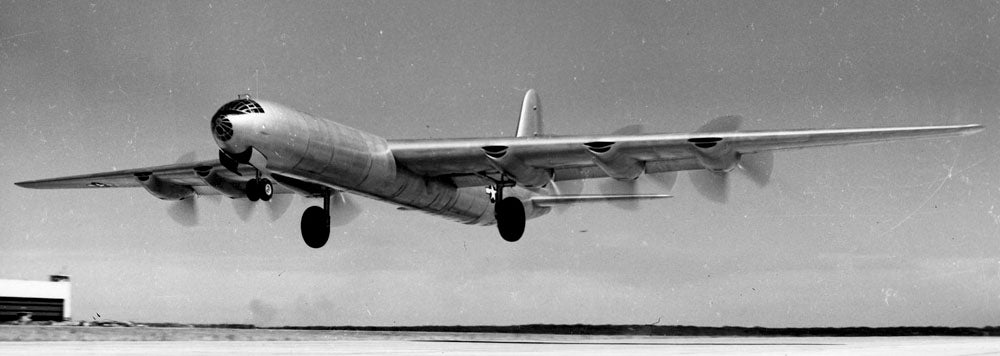
Convair XB-36 prototype
The B-36 was the largest mass-produced piston-powered aircraft ever built, dwarfing the B-29 and, at 230 ft, its wingspan was longer than any combat aircraft ever produced. Initially, the B-36 was powered by six massive
!!!error: Indecipherable SUB-paragraph formatting!!!
28-cylinder radial engines in a pusher configuration, the same engines that powered the
!!!error: Indecipherable SUB-paragraph formatting!!!
and host of other large American warplanes. Later, four
!!!error: Indecipherable SUB-paragraph formatting!!!
turbojets were added to augment take off power and increase speed during bombing runs. Four bomb bays could carry up to 86,000 pounds of bombs, more than ten times the load carried by the
!!!error: Indecipherable SUB-paragraph formatting!!!
. It was also the only bomber capable of delivering the 43,600-pound
!!!error: Indecipherable SUB-paragraph formatting!!!
“earthquake bomb.” And though not originally designed to carry nuclear weapons, whose development was top secret at the time, the Peacemaker was modified to carry the
!!!error: Indecipherable SUB-paragraph formatting!!!
hydrogen bomb, the biggest and heaviest nuclear bomb ever produced. For defense, the B-36 had six retractable, remote-controlled turrets armed with a pair of 20 mm cannons each. The Peacemaker entered service with the
!!!error: Indecipherable SUB-paragraph formatting!!!
in 1948 and, in addition to its role as a nuclear deterrent, the RB-36 reconnaissance variant was flown on spying missions around the periphery of the Soviet Union and its client states. Despite being a weapon of war, no B-36 ever dropped munitions on an enemy, and with the introduction of Soviet jet fighters like the
!!!error: Indecipherable SUB-paragraph formatting!!!
, the B-36 was quickly rendered obsolete. A total 384 Peacemakers were built, and it was retired in 1959 with the introduction of the
!!!error: Indecipherable SUB-paragraph formatting!!!
.
(US Air Force photos)
!!! UNKNOWN CONTENT TYPE !!!
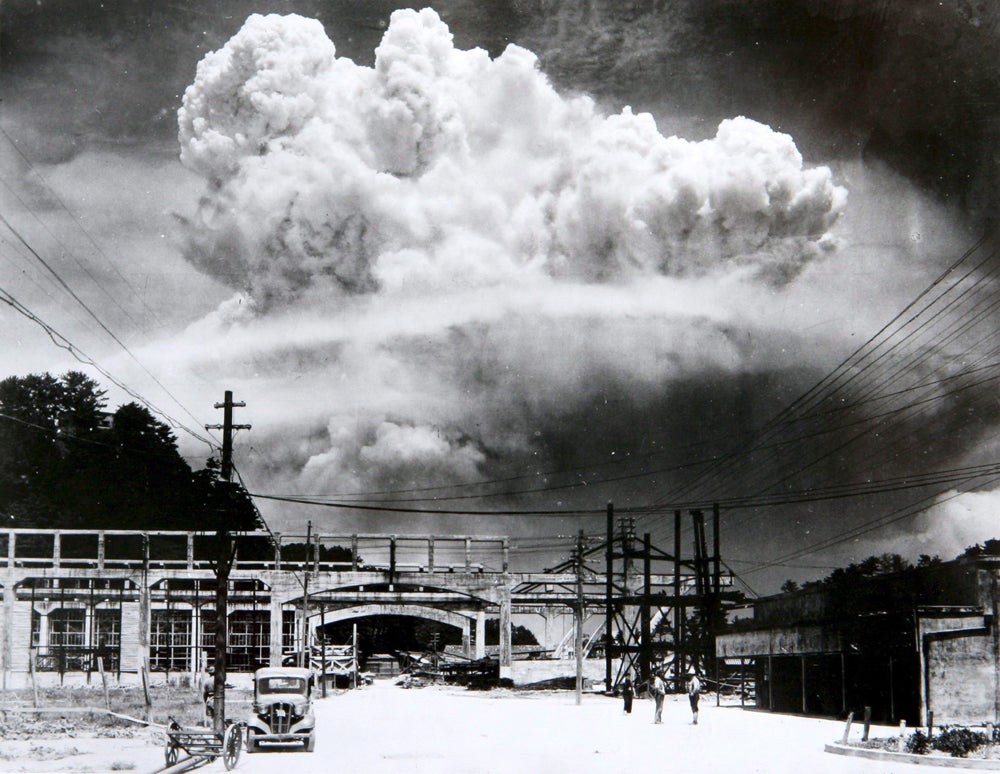
August 9, 1945 – The United states drops the Fat Man atomic bomb on the Japanese city of Nagasaki. While it was hoped that the bombing of Hiroshima on August 6 would compel the Japanese government to surrender, there was no sign that they were willing to do so. In fact, Japanese military leaders started making preparations for martial law that would prevent any Japanese from trying to make peace with the Allies. Following a dire warning from President Truman that more attacks would be forthcoming if the Japanese refused to capitulate, the American government made the decision to continue the nuclear bombing until Japan surrendered, and the next mission was slated for August 11, though predictions of poor weather over the target areas pushed the date up to August 9. The mission would be carried out by another !!!error: Indecipherable SUB-paragraph formatting!!! , this one named Bockscar after its regular commander, Capt. !!!error: Indecipherable SUB-paragraph formatting!!! . But Bock was not on the pilot rotation for the mission and the aircraft was instead commanded by Maj. !!!error: Indecipherable SUB-paragraph formatting!!! , who had accompanied the !!!error: Indecipherable SUB-paragraph formatting!!! on the Hiroshima mission. Bock accompanied the Nagasaki mission in a B-29 named !!!error: Indecipherable SUB-paragraph formatting!!! , which had also carried instruments to measure the blast at Hiroshima.
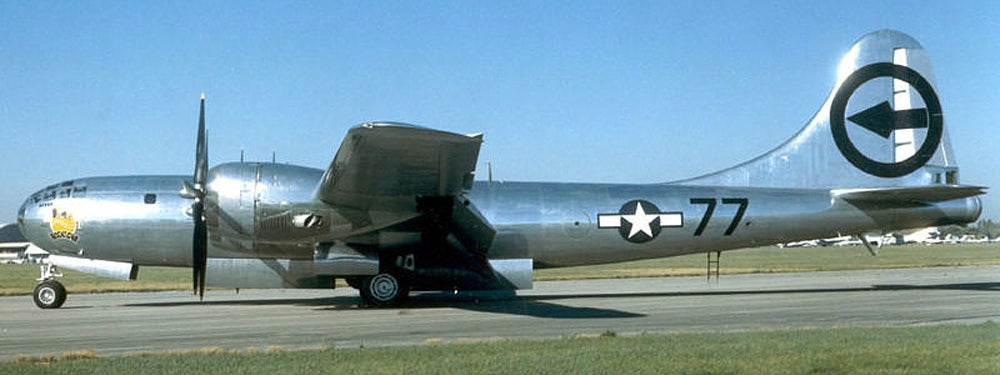
Bockscar at the National Museum of the US Air Force in Dayton, Ohio
At 3:49 am on August 9, Sweeney and his crew departed Tinian bound for the city of Kokura, the primary target for the mission. But, upon arriving over the city, they found that poor weather conditions and smoke from previous bombings obscured their view of the target. The crew elected to divert to their backup target, Nagasaki. During the war, Nagasaki was one of Japan’s largest seaports, and housed critical industries for the production of ordnance and shipping, and was home to the Mitsubishi Shipyard. Unlike other Japanese cities, it had not been subjected to firebombing since its location made it difficult to target at night. The city also had many more buildings of traditional wood construction, unlike Hiroshima which had more concrete buildings. At the time of the bombing, there were an estimated 263,000 people in the city, of which only 9,000 were Japanese soldiers. The rest were civilians, along with 2,500 conscripted Korean workers and 400 Allied POWs. The bomb chosen for the mission was codenamed
!!!error: Indecipherable SUB-paragraph formatting!!!
(officially Mark III), an implosion-type nuclear bomb with a solid plutonium core. When it detonated over Nagasaki, the blast from
Fat Man
was greater than 21,000 tons of TNT, and anywhere from 40,000 to 70,000 inhabitants were killed in the initial explosion and resulting fires. Only 400 people in underground shelters survived. The city of Nagasaki is nestled between mountains, and had the topography not contained the explosion, the death toll could have been considerably higher. Due to a pump failure on board
Bockscar
, the crew did not have access to 600 gallons of fuel, and they were unable to return to Tinian. Instead, they diverted to Okinawa and made an emergency landing on the busy airfield, firing flares to alert the controllers of their situation. With engines running out of fuel,
Bockscar
came to a stop behind a
!!!error: Indecipherable SUB-paragraph formatting!!!
that was waiting to take off. After the second atomic bombing, and with the
!!!error: Indecipherable SUB-paragraph formatting!!!
of yet more nuclear attacks, the Japanese government finally capitulated on August 15. The official surrender ceremony that ended the Second World War was held on board the battleship
!!!error: Indecipherable SUB-paragraph formatting!!!
(BB-63) in Tokyo Bay on September 2, 1945.
(Atomic cloud photo via Japanese Government;
Bockscar
photo via US Air Force)
!!! UNKNOWN CONTENT TYPE !!!
Short Takeoff
!!! UNKNOWN CONTENT TYPE !!!
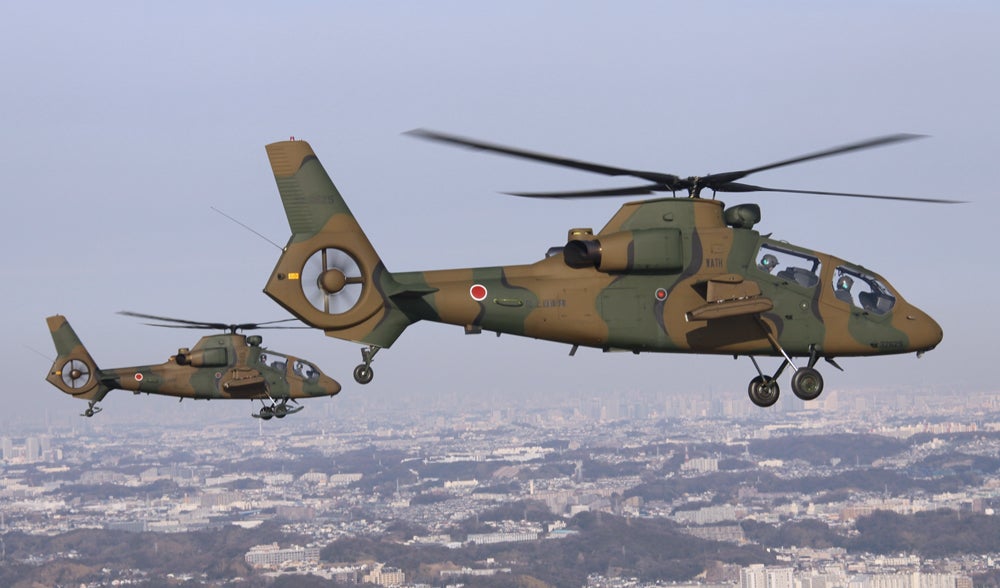
August 6, 1996 – The first flight of the Kawasaki OH-1, a military scout and observation helicopter developed for the Japan Ground Self-Defense Force and the first helicopter entirely produced in Japan. The OH-1 was created as a replacement for the !!!error: Indecipherable SUB-paragraph formatting!!! light observation helicopter (LOH or “Loach”) and entered service in 2000. The OH-1 is powered by two Mitsubishi TS1 turboshaft engines which provide a maximum speed of 173 mph, and an asymmetric !!!error: Indecipherable SUB-paragraph formatting!!! tail rotor that reduces noise and vibration. Development included an attack variant that was rejected in favor of the !!!error: Indecipherable SUB-paragraph formatting!!! , and 38 helicopters had been produced as of 2013. (Photo by Rikujojieitai Boueisho via !!!error: Indecipherable SUB-paragraph formatting!!! )
!!! UNKNOWN CONTENT TYPE !!!
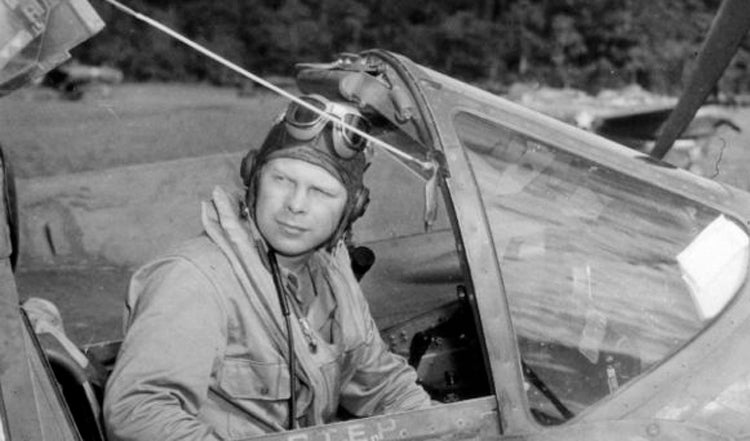
August 6, 1945 – The death of Richard Bong, one of the United States’ most decorated fighter pilots and the highest-scoring American ace of WWII. Bong was born in Superior, Wisconsin on September 24, 1920, and received his wings in January 1942. Bong, who flew the !!!error: Indecipherable SUB-paragraph formatting!!! exclusively, made the first of his 40 total victories on December 27, 1942. For his service, Bong was awarded the !!!error: Indecipherable SUB-paragraph formatting!!! in 1944 and was sent home to help sell war bonds. Following the war, Bong became a Lockheed test pilot, but was killed when the fuel pump of his !!!error: Indecipherable SUB-paragraph formatting!!! malfunctioned during takeoff. Bong ejected, but was too close to the ground for his parachute to open fully. (US Air Force photo)
!!! UNKNOWN CONTENT TYPE !!!
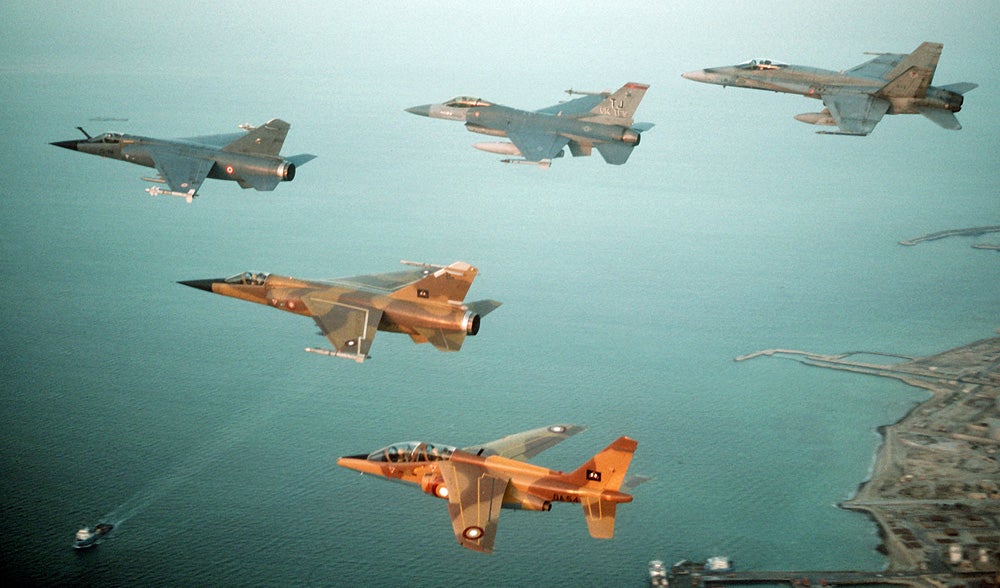
August 7, 1990 – Operation Desert Shield begins. Following the Iraqi !!!error: Indecipherable SUB-paragraph formatting!!! of Kuwait on August 2, 1990, US President !!!error: Indecipherable SUB-paragraph formatting!!! deployed US forces to Saudi Arabia to protect their strategic ally from further aggression from Iraqi President !!!error: Indecipherable SUB-paragraph formatting!!! . Air assets of the US Air Force and US Navy teamed with aircraft from Saudi Arabia, Great Britain and France, eventually forming a coalition of 48 nations resolved to oust Saddam from Kuwait. Following 5 months of air operations to protect the buildup of 120,000 soldiers, Operation Desert Shield became Operation Desert Storm, with the Coalition invasion to liberate Kuwait beginning on January 17, 1991 in what would come to be known as the !!!error: Indecipherable SUB-paragraph formatting!!! . (US Air Force photo)
!!! UNKNOWN CONTENT TYPE !!!
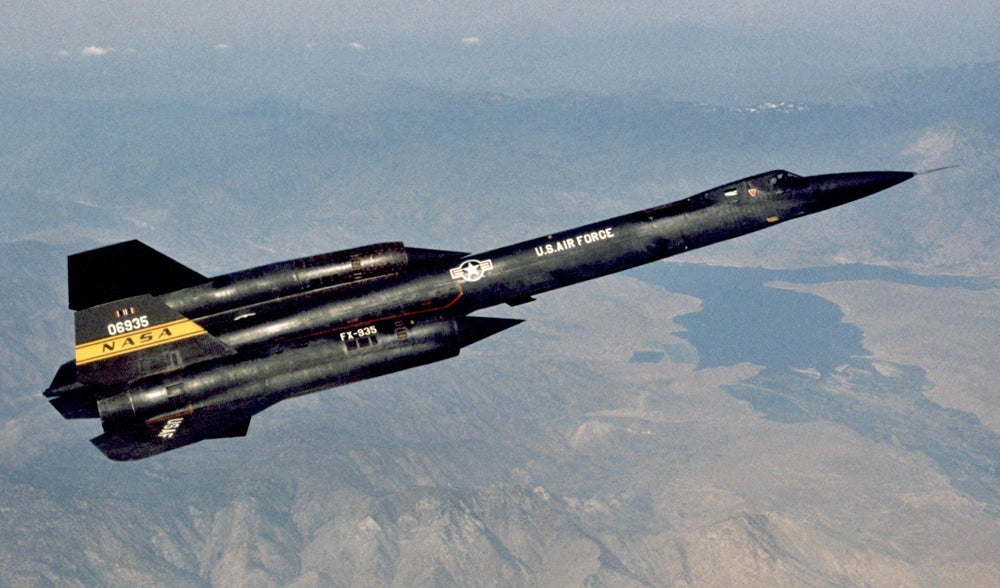
August 7, 1963 – The first flight of the Lockheed YF-12, a two-seat interceptor variant of the !!!error: Indecipherable SUB-paragraph formatting!!! reconnaissance aircraft. The YF-12 was developed in response to an Air Force requirement for an interceptor to replace the !!!error: Indecipherable SUB-paragraph formatting!!! that would be capable of speeds up to Mach 3. Following the cancelation of the !!!error: Indecipherable SUB-paragraph formatting!!! , Lockheed’s !!!error: Indecipherable SUB-paragraph formatting!!! proposed version of the A-12 that would be fitted with the !!!error: Indecipherable SUB-paragraph formatting!!! fire control system and armed with !!!error: Indecipherable SUB-paragraph formatting!!! missiles, specially modified to be fired by the YF-12 from internal missile bays. The Air Force ordered 3 prototypes and, during flight testing, the YF-12 set speed and altitude records for an interceptor of 2,070 mph and 80,257 feet. The YF-12 program was canceled in 1968, though the prototypes served as NASA test aircraft until 1979. (NASA photo)
!!! UNKNOWN CONTENT TYPE !!!

August 7, 1951 – The first flight of the McDonnell F3H Demon, a single-seat fighter and interceptor developed for the US Navy as the successor to the !!!error: Indecipherable SUB-paragraph formatting!!! . Unlike other fighters that were swept-wing versions of earlier sraight-winged aircraft, the Banshee was designed from the start with swept wings in an effort to counter Soviet fighter aircraft, though it was not capable of supersonic flight. Problems with engines plagued the Demon throughout its service life, and it was retired before it could serve in the Vietnam War. Despite difficulties with the Demon’s development, it ultimately served as the basis for the design of the !!!error: Indecipherable SUB-paragraph formatting!!! , which replaced it in Navy service. (US Navy photo)
!!! UNKNOWN CONTENT TYPE !!!
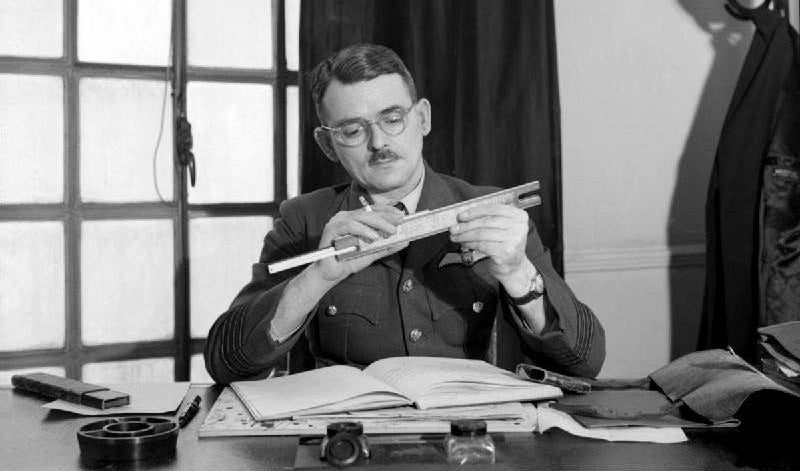
August 9, 1996 – The death of Sir Frank Whittle,
an engineer who served with the Royal Air Force in WWII and is given credit for inventing the
!!!error: Indecipherable SUB-paragraph formatting!!!
engine (Germany’s
!!!error: Indecipherable SUB-paragraph formatting!!!
, who worked independently from Whittle, receives credit for the first operational jet engine). Following work on development of the
!!!error: Indecipherable SUB-paragraph formatting!!!
concept, Whittle’s breakthrough came when he replaced the motorjet’s piston engine with a turbine and patented the concept in 1930. However, the British government saw little value in Whittle’s engine, so he formed
!!!error: Indecipherable SUB-paragraph formatting!!!
to develop the engine on his own. By 1940, the Air Ministry finally placed a contract with Whittle to put his engine in the
!!!error: Indecipherable SUB-paragraph formatting!!!
test aircraft, which first flew on May 15, 1941, and then the
!!!error: Indecipherable SUB-paragraph formatting!!!
, the Allies’ only operational jet fighter of WWII.
(British Government photo)
!!! UNKNOWN CONTENT TYPE !!!
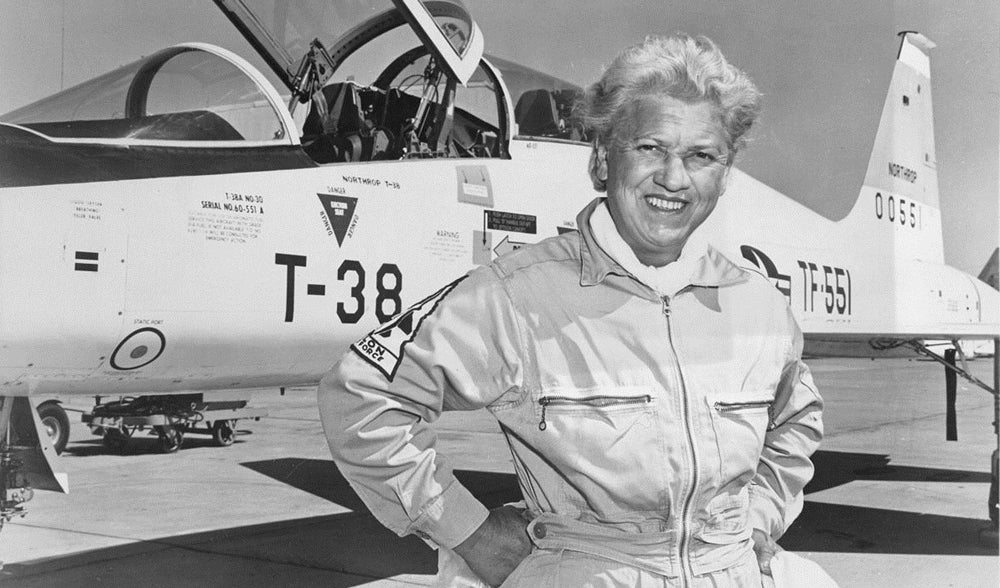
August 9, 1980 – The death of Jaqueline “Jackie” Cochran. Cochran was born on May 11, 1906 in Muscogee, Florida and learned to fly after just three weeks of instruction. In the 1930s, Cochran was the only woman to compete for the !!!error: Indecipherable SUB-paragraph formatting!!! , won five !!!error: Indecipherable SUB-paragraph formatting!!! , and still holds more speed, distance and altitudes records than any other pilot, male or female. During WWII, Cochran helped establish the !!!error: Indecipherable SUB-paragraph formatting!!! (WASP), in which women pilots were trained to ferry military aircraft in the US to free up male pilots for war duty. After the war, Cochran continued setting records in jet aircraft, becoming the first woman pilot to break the sound barrier while piloting a !!!error: Indecipherable SUB-paragraph formatting!!! in 1953. She was also the first woman to land and take off from an aircraft carrier. Cochran died in 1980 at the age of 74. (US Air Force photo)
!!! UNKNOWN CONTENT TYPE !!!
Recent Aviation History Posts
!!! UNKNOWN CONTENT TYPE !!!
!!! UNKNOWN CONTENT TYPE !!!
!!! UNKNOWN CONTENT TYPE !!!
!!! UNKNOWN CONTENT TYPE !!!
If you enjoy these Aviation History posts, please let me know in the comments. And if you missed any of the past articles, you can find them all at
!!!error: Indecipherable SUB-paragraph formatting!!!
.
!!! UNKNOWN CONTENT TYPE !!!
 Viggen
> ttyymmnn
Viggen
> ttyymmnn
08/09/2016 at 13:34 |
|
Good post! Missed a good chunk of these.
 facw
> ttyymmnn
facw
> ttyymmnn
08/09/2016 at 13:36 |
|
Those are some big-ass tires on the main landing gear of the XB-36.
 RallyWrench
> ttyymmnn
RallyWrench
> ttyymmnn
08/09/2016 at 13:58 |
|
Man, I can’t imagine the gravity of the B-29s sitting on the ramp after those missions, knowing what they’d done.
On a more positive note, that Desert Shield picture is really cool.
 facw
> RallyWrench
facw
> RallyWrench
08/09/2016 at 14:19 |
|
The crews claim, at least, not to be bothered by it (and of course they didn’t know about the horrible radiation sickness, to them it was purely a big bomb, and bombing of civilians had been going on the whole war).
Still that was my feeling looking into the cockpit of Enola Gay. Just the immense burden on the guy who had to sit there and drop the bomb.
 ttyymmnn
> RallyWrench
ttyymmnn
> RallyWrench
08/09/2016 at 14:22 |
|
I spent a LONG time looking for that photo. It was perfect.
 ttyymmnn
> facw
ttyymmnn
> facw
08/09/2016 at 14:25 |
|
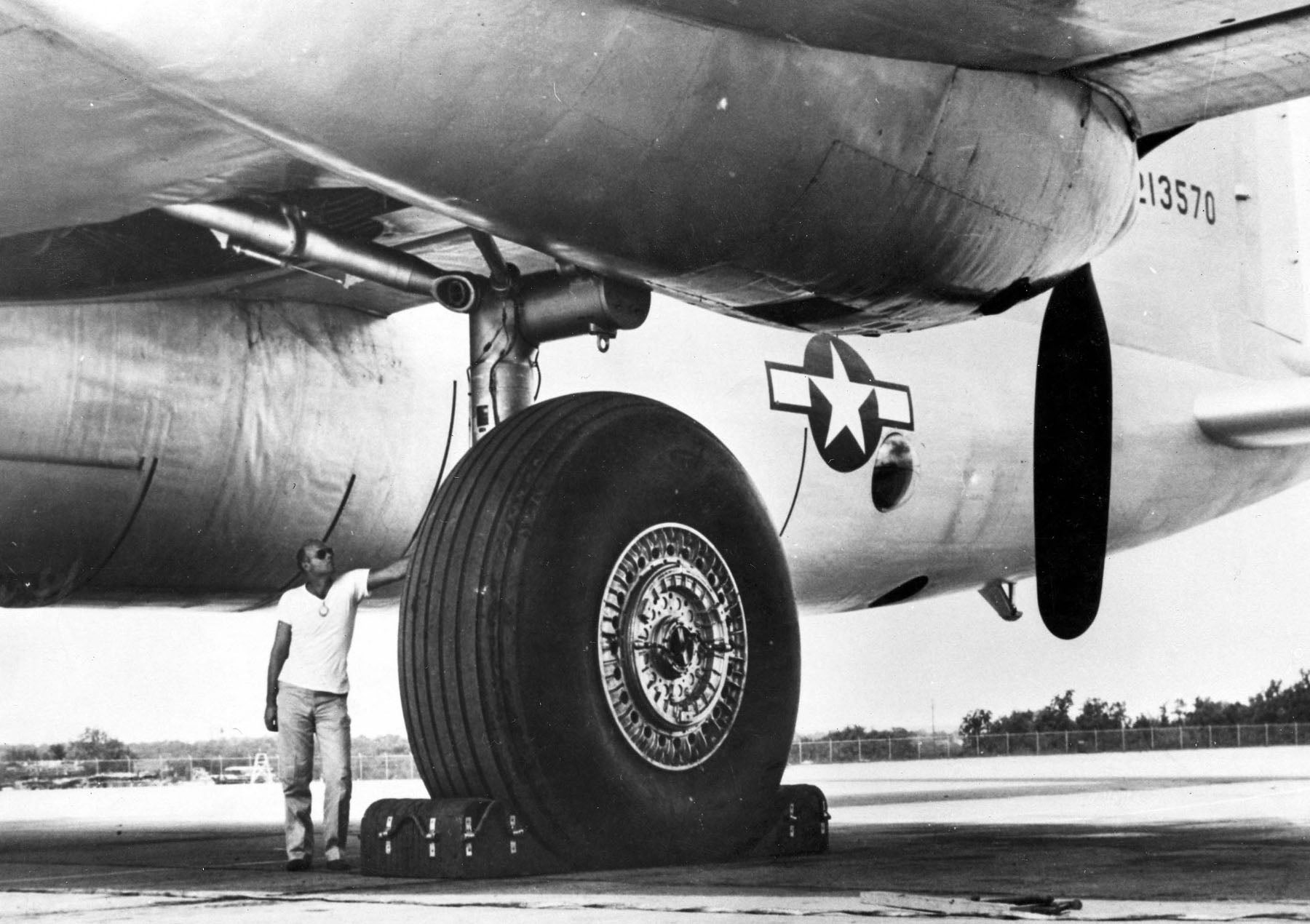
Yup. That’s why they changed them to a set of four smaller wheels per side. That single pressure point for all that weight was trashing the runways. They also experimented with tracked landing gear, but they dumped that idea pretty quickly.

 ttyymmnn
> Viggen
ttyymmnn
> Viggen
08/09/2016 at 14:26 |
|
Thanks! You can find them all.... you probably already knew that. Thanks for reading!
 user314
> facw
user314
> facw
08/09/2016 at 14:30 |
|
Largest single wheel gear manufactured up to that point. (Images are Kinja’d at work, so linked instead) Convair switched to a four tire arrangement after it was found that ground pressure from the single tire limited the B-36 to just three bases: Carswell Field adjacent to the Consolidated factory in Fort Worth, Texas; Eglin Field in Florida and Fairfield-Suisun Field (now Travis AFB ) in California. They also tried a tracked main gear to add rough field capability, but they were heavy and noisy (let that thought sink in, it was too noisy for a plane with six props and four jets....).
 RallyWrench
> facw
RallyWrench
> facw
08/09/2016 at 15:10 |
|
I suppose they really didn’t know what they’d done at the time, but seeing the image now gives me chills. I hope to visit Hiroshima someday.
 sunnydaysam
> ttyymmnn
sunnydaysam
> ttyymmnn
08/09/2016 at 15:50 |
|
Outstand post, ttyymmnn! I like them all but this one is my new favorite! and your Hiroshima article is one of the most accurate and succinct I’ve ever read. There’s a lot of ‘debate’ about that bombing but my late Father-in-Law was a Marine on a troop ship almost to Japan to invade it when they heard of the bombs and the surrender. He told me they saved his life. When he drove ashore there were no Japanese to be seen and the .50 cal machine guns on his halftrack only had 5 rounds apiece to keep some Marine from going off on the civilians. Finally people came out of the hills and his unit gave them all the food they could spare. One other thing; had it not been for Enola Gay and Bockscar, I would never have met his daughter, my Wife of 34 years.
 ttyymmnn
> sunnydaysam
ttyymmnn
> sunnydaysam
08/09/2016 at 16:10 |
|
Thanks so much. I think that for all I’m an airplane nut, I am first and foremost a history nut, and great historical moments are so much more interesting to write about than the development of an aircraft. It is, after all, a story, and a very compelling one at that. My interest in WWII probably goes back 40 years, when I was first given a large coffee table book titled LIFE’s Picture History of WWII. It belonged to my grandparents (you can still find it on Amazon). And I have long appreciated the importance of the nuclear attacks on Japan, and have tried to understand them in the context of the war, beyond the war, and our current time. Had the atom bomb never been dropped on Japan, we would live in a nuclear-armed world with no real idea of the reality of death and human suffering that those weapons can bring. In a certain way, one might even try to see Hiroshima and Nagasaki as a noble sacrifice (though not one of their choosing) by the Japanese people to make sure that something like that never happens again. As much as I dislike the entire concept of nuclear weapons, I do believe that their use brought a swift end to the war. Though the end was inevitable, it would almost certainly have been a catastrophe for both sides. All that said, it is very possible that the doctrine of Mutually Assured Destruction has, in a perverse way, kept the world from starting WWIII, because that really will be the war to end all wars.
Thanks for reading, both the post and this lengthy comment!
 sunnydaysam
> ttyymmnn
sunnydaysam
> ttyymmnn
08/09/2016 at 16:38 |
|
My Father was a flight engineer on B-17, B-24, and then B-29's in the Pacific in WW2 and he said much the same as you do about the use of the bomb. He was and I am, an aviation fanatic and a lover of all things History, especially WW2 because I had my Dad and 3 uncles who served in that so I got a lot of first hand information from them.
 ttyymmnn
> sunnydaysam
ttyymmnn
> sunnydaysam
08/09/2016 at 16:42 |
|
Well, then you must be even older than me! Everything I know I learned second hand. It must have been inspiring to hear it from a primary source!
 sunnydaysam
> ttyymmnn
sunnydaysam
> ttyymmnn
08/09/2016 at 19:36 |
|
I’ll have to post the picture of me and Orville Wright ;) yeah, there’s nothing like the first-hand testimony, but those guys are going fast and almost gone. I try to seize every opportunity.
 ttyymmnn
> sunnydaysam
ttyymmnn
> sunnydaysam
08/09/2016 at 20:17 |
|
My father in law was in the Marine Corps (he passed a few years ago, and was interred at Arlington with full military honors). He was an enlisted man in Korea, then did two tours of Vietnam after OCS. He never spoke much of it, but I think that was more out of humility than anything else. Towards the end of his life, he spent a lot of time in bed, and we had an evening together when he told a handful of stories from his tours. On one tour, he commanded a fire base, and on the other, he was an advisor for a local militia. He wasn’t terribly kind to his cadre of villagers, who were known for taking naps every afternoon regardless of the tactical necessities of ambushes and blocking maneuvers. He was quite a man and, regardless of how old fashioned it seemed, you better believe I asked his permission to marry his daughter.